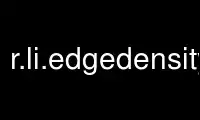
This is the command r.li.edgedensitygrass that can be run in the OnWorks free hosting provider using one of our multiple free online workstations such as Ubuntu Online, Fedora Online, Windows online emulator or MAC OS online emulator
PROGRAM:
NAME
r.li.edgedensity - Calculates edge density index on a raster map, using a 4 neighbour
algorithm
KEYWORDS
raster, landscape structure analysis, patch index
SYNOPSIS
r.li.edgedensity
r.li.edgedensity --help
r.li.edgedensity [-b] input=name config=name output=name [patch_type=string]
[--overwrite] [--help] [--verbose] [--quiet] [--ui]
Flags:
-b
Exclude border edges
--overwrite
Allow output files to overwrite existing files
--help
Print usage summary
--verbose
Verbose module output
--quiet
Quiet module output
--ui
Force launching GUI dialog
Parameters:
input=name [required]
Name of input raster map
config=name [required]
Configuration file
output=name [required]
Name for output raster map
patch_type=string
The value of the patch type
It can be integer, double or float; it will be changed in function of map type
DESCRIPTION
r.li.edgedensity calculates:
· the density of all edges of patch type k , or
· the density of all edges in the sampling area if k is not specified,
with:
· k: patch type
· m: number of patch types
· n: number of edge segments of patch type k
· eik :total edge length in the landscape involving patch type k
· Area: total landscape area
The unit is meters per hectare.
NOTES
Do not use absolute path names for the config and output file/map parameters. If the
"moving window" method was selected in g.gui.rlisetup, then the output will be a raster
map, otherwise an ASCII file will be generated in the folder
C:\Users\userxy\AppData\Roaming\GRASS7\r.li\output\ (MS-Windows) or
$HOME/.grass7/r.li/output/ (GNU/Linux).
If the input raster map contains only NULL values then r.li.edgedensity consider to have 0
patches.
If area is 0 r.li.edgedensity returns NULL; this is only possible if input raster is
masked.
EXAMPLES
To calculate the edge density index on map my_map, using my_conf configuration file
(previously defined with g.gui.rlisetup) and saving results in my_out, run:
r.li.edgedensity input=my_map conf=my_conf output=my_out
To calculate edge density index of patch_type 34, using "my_conf" configuration file and
on map "my_map", saving results in "my_out" file run:
r.li.edgedensity input=my_map conf=my_conf output=my_out patch_type=34
Forest map (Spearfish sample dataset) example:
g.region raster=landcover.30m -p
r.mapcalc "forests = if(landcover.30m >= 41 && landcover.30m <= 43,1,null())"
r.li.edgedensity input=forests conf=movwindow7 out=forests_edgedens_mov7
r.univar forests_edgedens_mov7
Forest map (North Carolina sample dataset) example:
g.region raster=landclass96 -p
r.mapcalc "forests = if(landclass96 == 5, 1, null() )"
r.li.edgedensity input=forests conf=movwindow7 out=forests_edgedensity_mov7
# verify
r.univar forests_edgedensity_mov7
r.to.vect input=forests output=forests type=area
d.mon wx0
d.rast forests_edgedensity_mov7
d.vect forests type=boundary
Use r.li.edgedensitygrass online using onworks.net services
